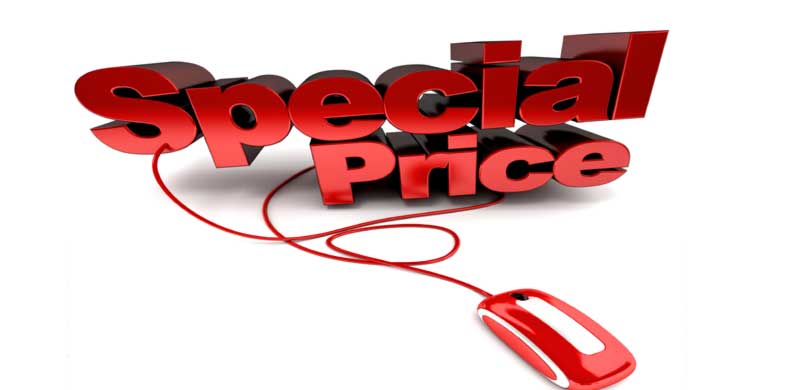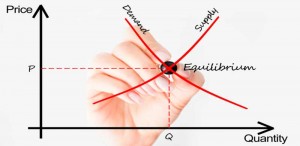 Rethinking Pricing
Rethinking Pricing
Introduction
Pricing products or services used to be a relatively straightforward process.
You would:
- Calculate your costs
- Determine how much profit you wanted to make, and
- Add appropriate brand value.
You would then tweak your pricing model a little bit with promotions, clearance sales, supply and demand considerations, seasonality, and product life cycles.
You then tested your model a little and, Voila! — prices were set forever — well, at least until you had a cost increase or a price war broke out with your competitor.
 So much for the simple “Good Ol’ Days…”
So much for the simple “Good Ol’ Days…”
Our traditional notion about how to price our products and services has undergone a complete transformation in recent years.
Consider the following:
- Production and distribution techniques have changed dramatically and become much more efficient. This has resulted in great value and pricing opportunities for huge retailers such as Wal-Mart, Costco, and Amazon to name a few
- The Internet now allows price changes to occur immediately, with instantaneous visibility and accessibility to consumers. An entire new “deal/discount” industry has been born from this shift, including companies such as Groupon, Gilt and others, and
- There is much greater diversity in consumer pricing behavior these days. The same consumer who will buy $ 1000 shoes in better department stores will go to places like T.J. Maxx and Amazon for unbranded commodities at 20-40% off.
Despite the increased complexity and ever-changing nature of today’s pricing environment, there are still some basic rules and simple tips you can follow to build your market share, make money in the process, and establish long term success.
Here are some considerations to review to maximize your pricing results.
Branding
The two most touted but diverse strategies to develop effective pricing are:
- “Build a brand and charge whatever the market will support” and
- “You can make it up with volume.”
$1000 designer purses and Amazon represent successful examples of these extremes.
If you can build a differentiated brand, it is generally the most effective strategy. However, the “if” in this equation requires that you develop an integrated and frequently expensive marketing program to support your brand. This often includes not only a great product, but a program to communicate its quality, its image, its service and many other attributes that require sound marketing, advertising, and promotion. It is well to remember that many of the best brands have taken years to develop compared to the short time spans and limited resources that startups generally have.
What are you really selling and what is the customer buying?
Product definitions keep changing. Airlines add new fees, restaurants keep bundling their meal offerings, and warrantees keep changing in both price and characteristics. One of the most critical aspects of pricing which is frequently considered from more of a cost perspective is the product or service itself.
What are the components, quality, service, presentation, and add on characteristics?
What is your competition doing and what do your customers expect? For example warehouse clubs thrive by selling multiple units at lower prices per unit while other industries like candy bars and coach airline seats raise prices by creating the ever-shrinking product. Ingredients and contents can also change. When cotton prices soared for the apparel industry many suppliers switched to polyester at lower costs. In the tech sector, chip prices keep declining and technology companies seem to add more memory rather than lowering prices on existing models.
Product pricing is also affected by bundling and unbundling or to coin a phrase, “Do you sell it your way or our way?” Bundling — if done correctly — can both improve a product offering and satisfy the customer, such as selling complete meals or LEGO sets. Bundling can also be a way to increase profits by adding elements such as high margin warranties to low margin items like electronics. Bundling can also enhance sales and value such as offering extra services in places like fitness centers or nail salons. While shipping used to be considered an element of Bundling, free shipping with minimum purchases has now become almost an essential part of the pricing and shopping experience, both on the internet and with brick-and-mortar stores.

In the final analysis, it is individual consumers who will determine the effectiveness of your pricing strategy.
In contrast, unbundling can provide both value and customized products, so that customers don’t buy products they don’t want or need. Computer companies let you build your own model to your own needs. Many automobile companies feature the same “custom design option” — now often over the internet. As an aside, every time I try to “unbundle” and buy a customized product, I end up with more than I need at a higher price. Unbundling has become so popular, however, I have to assume there are many people who know how to do it right. Spirit Airlines offers no frills fares and charges for every service to maintain perceived low prices. Generic brands represent another form of unbundling by charging lower prices in exchange for brand marketing and reputation.
Pricing psychology can also dramatically affect your success. After you have worked long and hard to develop a rational pricing strategy, remember consumers can react strongly to psychological presentations that we all understand conceptually but frequently ignore in the moment. These can include practices such as pricing at “$9.95”(instead of $10.00), eliminating the actual dollar sign, unmonitored purchase limits, offering some items for free, selling two for $9.95, changing colors, and font sizes, etc. The list of factors that can influence consumer pricing psychology is long and complex, and it is essential to factor it into you’re rethinking of pricing.
Maximizing opportunities by varying prices
One of the most successful efforts by sports teams and airlines is variable pricing. The simplest thing is they have ranges in seat prices by location and quality. First Class versus coach or company box versus general admission for the same ticket can vary from up to a thousand dollars and more. The biggest change however is in varying prices by time, seasonality, holiday etc to develop revenue in off peak periods etc.
While these examples utilize sophisticated and expensive computer models, the most noted model is very simple. Specifically the early bird special in Florida has been around as long as I can remember. Similarly, vendors seem to suddenly appear in major urban markets when it starts to rain with overpriced umbrellas.
Understanding and communicating prices is another way to differentiate your products. Few people actually understand the basis for pricing of products such as cars, credit cards, phones, airlines, happy meals, etc.
Freemium
The concept of “Freemium” is more than a business model. It’s also a pricing strategy. Offer a free product or service, then offer ‘pay-to-upgrade’ features, and you have a Freemium strategy. Remember that companies like Google and Facebook were built on free offerings for entry, followed by a host of upgrades and “for pay” services. Ancillary aspects of the Freemium strategy include samples, blogs, demonstrations, contributions to charities, etc. — these can all create awareness and build long term volume at little or no initial price. An older variation is to basically “give away razors and printers” to sell the “blades and ink.”
Promotions
Contrary to some popular opinion, “Promotion” is not a dirty word and the use of promotions is not synonymous with diluting the value of your brand. New outlets (like flash sites or Amazon), bundling, seasonal programs, etc., are several of many valid ways to offer promotions and discounts in order to increase volume without diluting your brand. There are a near-limitless number of ways to offer promotions without downgrading your brand or its image. And, let’s face it — today’s consumer expects promotions. Here are a couple of promotion concepts:
- Essential to the process of effective pricing is to understand the entirety of your product mix. Getting people into the store with loss leaders is a proven strategy. For Seasonal retailers the use of such promotions as “back-to-school” or “holidays” drive traffic to the store (or website), where they thrive on specials and often buy other products NOT on special.
- Product costs can be greatly affected by promotions, buying shelf space, markdowns, packaging, inventory requirements, returns, etc.
No document about rethinking pricing would be complete without a discussion of the effective use and understanding of the ever-changing environment of the internet. Selling direct, selling through Amazon or eBay, linking with flash sites, affiliating with industry sites, etc., are all valid distribution vehicles that employ ecommerce and the internet. Most importantly, customers are checking the internet with increasing frequency, so you must be extremely vigilant about your competition and how your product’s pricing compares.
Service and Quality
Many customers will opt to stay with a company in large part because of the quality their service after the sale.
Efficiencies of Logistics, Sourcing and Distribution
Another aspect of pricing strategy that can provide major competitive advantages has to do with logistics, sourcing and distribution efficiencies. These may be used to reduce costs for you and prices for your customers. For example, Amazon is able to employ such efficiencies to operate on a 15-20 percent margin while traditional retailers have to work on 40-50 percent margins. Similarly, shipping times, delivery methods, using direct shipping, etc., can affect inventory management costs, all of which translate into pricing at the point-of-sale.
While pricing has become more complex it also provides more opportunities for success.
Entrepreneurs who recognize that traditional pricing models no longer apply in today’s world of business, will be better able to price their goods and services appropriately in this “Brave New World.”
Profit and Pricing

Don’t lose sight of the very real fact that at the end of the day your pricing strategy absolutely MUST generate sufficient profit for you to support and grow your business.
While pricing strategies can vary widely depending upon the factors we have discussed above, ultimately the survival and growth of your enterprise depends upon your ability to price your products or services at a profit that enables you to re-invest into your company, be it in research, expansion, employee retention or investor dividends.
In order to be sure that your pricing allows for such profit, a thorough and accurate model of your direct and indirect cost structure needs to be in place, and you need to know what the sustainable level of gross margin and pre-tax profit is for your industry sector. If your margins are too high for your industry, you either need to be able to substantiate your added value or be prepared for competitors to emerge on the scene and start eroding your market share.
Final Words on Rethinking Pricing
Pricing of products and services for startups is much more complicated today than it was even ten years ago. However, a good pricing strategy is really is an essential element of your overall plan to maximize your company’s marketing efforts. A well-thought-through pricing strategy can accelerate segmentation, enhance the value of your branding, maximize opportunities to remain competitive and generate sustainable profits. The important aspect when rethinking your pricing strategy is to aggressively manage and innovate your entire pricing package rather than simply reacting to short-term changes in the market or competitive pressures.